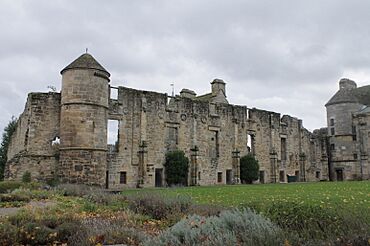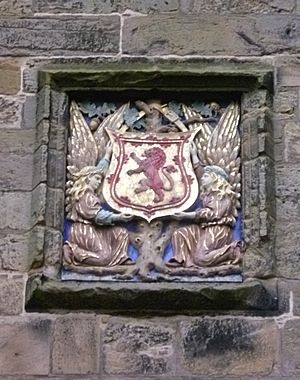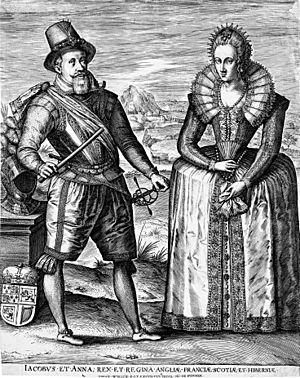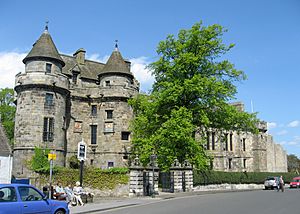Falkland Palace facts for kids
Quick facts for kids Falkland Palace |
|
|---|---|
 |
|
| General information | |
| Location | Falkland, Fife, Scotland |
| Coordinates | 56°15′14″N 3°12′23″W / 56.25389°N 3.20639°W |
Falkland Palace, located in Falkland, Fife, Scotland, is a royal palace that once belonged to the kings and queens of Scotland. It was a favorite retreat for Mary, Queen of Scots, who often visited to escape the busy world of politics.
Today, the palace is cared for by the National Trust for Scotland. The Chapel Royal inside the palace is a place of worship and is open to the public.
Contents
The Palace's Early History
From Hunting Lodge to Castle
Long ago, in the 12th century, a royal hunting lodge stood on this spot. By the 13th century, it had grown into a strong castle owned by the Earls of Fife. The castle was built on a small hill, making it easy to defend.
The castle was surrounded by meadows, orchards, and a large managed forest called Falkland Park. A special fence, known as a pale, kept deer and other game inside the park for the royals to hunt.
In 1402, a dramatic event happened here. The Duke of Albany, Robert Stewart, imprisoned his own nephew, David Stewart, Duke of Rothesay, in the castle. Rothesay was the heir to the throne, but he died while being held prisoner. This event led to the downfall of the Albany Stewart family. When King James I came to power, he took Falkland for the crown in 1424.
A Favorite Royal Retreat
Falkland became a popular getaway for all the Stewart kings and queens. They enjoyed falconry (hunting with trained falcons) and used the large forests for hawking. Deer were kept in the park for hunting.
King James II gave Falkland to his wife, Mary of Guelders. She loved the palace and made many improvements, including building new stables and a new kitchen. As a widow, she added a special staircase from her room to the garden and even had a "gallery" built, which was a new idea at the time.
James III and his wife, Margaret of Denmark, also spent time at Falkland. The palace was an important part of the royal family's life.
The Grand Renaissance Palace
James IV and James V
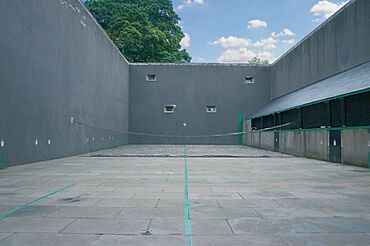
Between 1497 and 1541, James IV and his son James V transformed the old castle into a stunning Renaissance palace. They were inspired by the grand buildings they had seen in France.
James V had a special love for Falkland. As a teenager, he was held at the palace by a powerful noble, the Earl of Angus. One night, he escaped by dressing up as a stable hand and riding his horse to Stirling Castle.
As king, James V added many new features to Falkland. He built one of the world's oldest royal tennis courts in 1541, which is still in use today. The game was called caichpule in Scots.
Mary of Guise at Falkland
James V's wife, Mary of Guise, also loved the palace. She would spend her time here embroidering her husband's shirts with gold thread. The royal couple played cards and enjoyed the beautiful gardens. They even kept wild boar, imported from France, in the park for hunting.
Sadly, King James V died at Falkland Palace in December 1442. He was heartbroken after his army's defeat at the Battle of Solway Moss. His body lay in the Chapel Royal for almost a month before being taken to Holyrood Abbey.
Mary, Queen of Scots and Falkland
Mary of Guise continued to visit Falkland after her husband's death. Her daughter, Mary, Queen of Scots, also found peace at the palace. After returning from France in 1561, she often came to Falkland.
Mary enjoyed country life here. She was known to play tennis on the royal court, sometimes wearing men's pants, which was unusual for the time. She also held special ceremonies at the palace, like on Maundy Thursday, when she would wash the feet of young women whose number matched her age.
James VI and a Royal Quarrel
Mary's son, James VI, also spent a lot of time at Falkland. He gave the palace to his wife, Anne of Denmark, as a wedding gift. The palace was a lively place, with musicians, entertainers, and even an African drummer performing for the king.
The Raid of Falkland
In June 1592, a rebellious noble, the Earl of Bothwell, tried to capture the king and queen at the palace. Bothwell and his 400 men attacked the gates, but the king's guards fought them off. The king and his men fired guns from the gatehouse tower, and after five hours, Bothwell gave up and fled.
A Royal Disagreement
James VI and Queen Anne had a serious disagreement about their son, Prince Henry. The king wanted Henry to be raised at Stirling Castle by the Earl of Mar, but Anne wanted her son with her.
The court took sides in the argument. To help them make up, James convinced Anne to come to Falkland in 1595. A royal chaplain gave a sermon about the duties of a husband and wife, and it seemed to help. Soon, the king and queen were "lovingly together at Falkland" once more.
The Palace in Later Years
The Last Royal Visits
After the Union of the Crowns in 1603, when James VI also became King of England, the royal family spent less time in Scotland. King James visited in 1617, and the palace was repaired for his arrival. His son, Charles I, and grandson, Charles II, also stayed at Falkland.
During the English Civil War, soldiers occupied the palace. A fire broke out and badly damaged the building, and it began to fall into ruin.
19th-Century Restoration
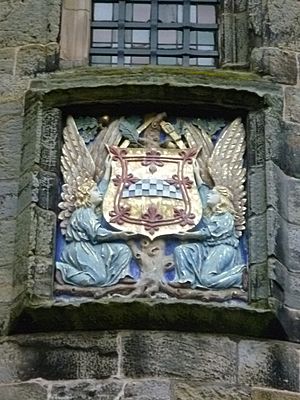
For many years, the palace was a ruin. But in 1887, John, the 3rd Marquess of Bute, bought the estate. He was a very wealthy man who loved history and architecture. He spent 20 years and a lot of money carefully restoring the palace to its former glory. Thanks to his work, the palace still stands today.
The Palace Today
In 1952, the palace was given to the National Trust for Scotland, which now cares for the building and its beautiful gardens. Visitors can explore the restored rooms, the historic Chapel Royal, and the ancient tennis court.
The Gardens of Falkland Palace
The gardens at Falkland have a long and rich history. The first garden was recorded in 1451. In the 1500s, it grew fruit, onions, and herbs for the royal kitchen.
Today, the gardens are a mix of different styles from different time periods. In the 1940s, garden designer Percy Cane created new layouts with beautiful curvy flower borders.
The garden team at Falkland is now working to encourage wildlife. They have planted a wildflower meadow, which attracts bees, butterflies, and other insects. These insects help pollinate the fruit trees in the orchard. The gardens are now home to many species of flies, bats, and even red squirrels, which are an endangered species in Scotland.
Palace Architecture
The palace is built in an 'L' shape with a South and an East wing, called Quarters. The outside walls of the South Quarter have small openings called gunloops for defense. Above them are the large windows of the Chapel Royal.
The courtyard walls are decorated in a French Renaissance style, similar to grand French castles like the Château de Villers-Cotterêts. This beautiful design was added by King James V in the 1530s.
The chapel has a magnificent painted ceiling that dates back to the time of James V. It was re-decorated in 1633 for the visit of King Charles I.
Images for kids
See also
 In Spanish: Palacio de Falkland para niños
In Spanish: Palacio de Falkland para niños


